Page 1 of 1
A couple of classicals
Posted: Tue Oct 16, 2012 5:46 pm
by Trevor Gore
Here's a couple of classicals for your viewing entertainment:
The Engelmann one I finished a few weeks back; just finished the cedar neo-classical.
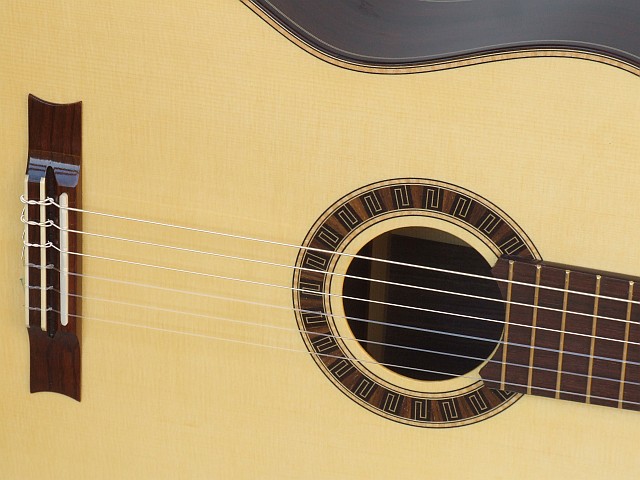
- Engelmann.jpg (81.28 KiB) Viewed 22534 times
The purflings are curly maple. The tiles in the rosette are rosewood from the sides and fretboard off-cuts.
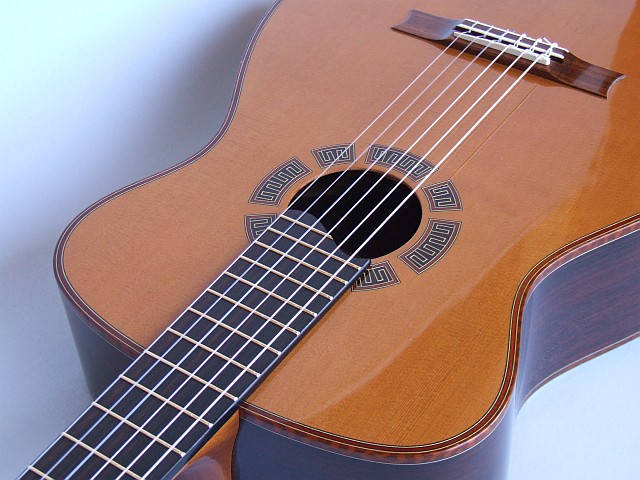
- Cedar Neo.jpg (100.9 KiB) Viewed 22534 times
The cedar one has bloodwood purfling and snakewood bindings....

- Snakey Binding.jpg (65.03 KiB) Viewed 22534 times
... and a magnetic armrest (requested by its new owner who tells me that N. Qld is hot...)
And here's a shot of the headstock:
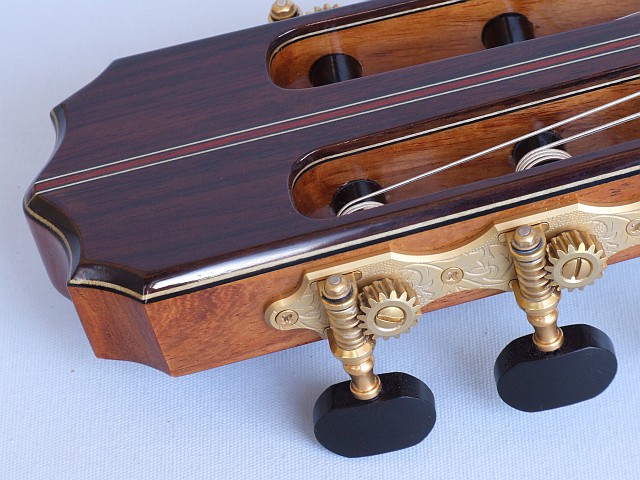
- Headstock_s.jpg (92.49 KiB) Viewed 22534 times
For both, the finish is nitro on the B&S (EIR) and hard shellac on the soundboards.
Re: A couple of classicals
Posted: Tue Oct 16, 2012 6:24 pm
by 56nortondomy
Very classy. Wayne
Re: A couple of classicals
Posted: Tue Oct 16, 2012 7:50 pm
by kiwinoz62
Nice one Trev, a touch of class. . .

Your wood selection compliment each other.
Re: A couple of classicals
Posted: Tue Oct 16, 2012 9:33 pm
by J.F. Custom
Lovely sharp work Trevor.

What bracing have these two been built with? I'll assume Falcate given the bridge design, but you may carry that into other bracing patterns too - I'm not sure.
So how do they sound? It's a given you hit your target frequencies on each, so how do they compare to each other?
Considering your previous issues with oil on bridges, what did you use on this occasion? Shellac? They are very shiny.
Finally, I assume you countersunk some rare earth magnets in the linings and/or inside sides. Does your armrest continue down the side edge a little as well? Did you notice any discernible effect on the frequencies with the arm rest installed and not installed?
Cheers,
Jeremy.
Re: A couple of classicals
Posted: Tue Oct 16, 2012 10:51 pm
by woodrat
Beautiful Work Trevor......




The Snakewood looks very nice.....indeed!
John
Re: A couple of classicals
Posted: Tue Oct 16, 2012 11:12 pm
by ozziebluesman
Crikey, those beauties are setting the bar high!
Simply outstanding.
Thanks for sharing the pictures.
I will continue to read and learn from you excellent guitar building books.
Cheers
Alan
Re: A couple of classicals
Posted: Wed Oct 17, 2012 7:15 am
by steve roberts
Hi Trevor
Great looking guitars - i agree with the others that you sure do set the bar high!
The books have been an absolute inspiration to me and have helped me no end.
Rgds
Steve Roberts
Re: A couple of classicals
Posted: Wed Oct 17, 2012 11:12 am
by Trevor Gore
Thanks for compliments! You blokes always impress me with the quality of the stuff you pump out. It's hard to keep up!
Jeremy had a few questions:
J.F. Custom wrote:What bracing have these two been built with?
Both falcate.
J.F. Custom wrote:So how do they sound?
The cedar is a 190Hz guitar, the spruce a 200Hz. So the cedar has a slightly darker tonality. The thing I'd comment on though is the tonal pliability. It's quite easy to make these guitars sound practically indistinguishable, in that their tonal palettes overlap quite a lot. The cedar one is still a little green so will sharpen up and get louder as the finish cures. That always seems to happen, but I don't always get to hear it if the guitar gets shipped out quickly. So it's a bit early to make comparisons, but they are both pretty loud and I like the tone of both.
J.F. Custom wrote:Considering your previous issues with oil on bridges, what did you use on this occasion? Shellac?
Yes. Drying oils, (linseed, walnut, etc.) work fine. It's just the non-drying alkanes in some of the fretboard treatments that cause problems.
J.F. Custom wrote:Finally, I assume you countersunk some rare earth magnets in the linings and/or inside sides.
In the linings (because I use fairly deep linings)
J.F. Custom wrote:Does your armrest continue down the side edge a little as well?
Yes.
J.F. Custom wrote:Did you notice any discernible effect on the frequencies with the arm rest installed and not installed?
No. The inside of the armrest is lined with felt, so is quite compliant. To work as side masses, they have to be
really securely attached. There's audibly less damping when the arm rest is on, as your forearm is off the soundboard, so definitely makes a difference for the better.
Re: A couple of classicals
Posted: Wed Oct 17, 2012 11:52 am
by J.F. Custom
Thanks for taking the time to answer my questions Trevor.

Jeremy.
Re: A couple of classicals
Posted: Thu Oct 18, 2012 5:12 am
by Steve_E
WoW!
I'm getting ready to start my first falcate classical (EIR/Engleman) and am looking forward to seeing how it turns out. I used the laminated bridge on the Classical I just finished and really like it.
Steve
Re: A couple of classicals
Posted: Thu Oct 18, 2012 7:40 pm
by Tod Gilding
Yes Magnificent Trevor, As has already been said ,you have the bar set high,I'm not sure that I want to put another of mine up here

Just a quick question and possibly a stupid one but wouldn't the rare earth mags be just as good for adding side mass as the T nuts and bolts ?
That question leads to another, can magnetic flux cause problems with piezo pickups ?
Re: A couple of classicals
Posted: Thu Oct 18, 2012 8:03 pm
by kiwigeo
Tod Gilding wrote:
That question leads to another, can magnetic flux cause problems with piezo pickups ?
Negative.....piezo pickups generate their signal by physical deformation of a crystal(s) contained within the pickup.
Re: A couple of classicals
Posted: Thu Oct 18, 2012 9:38 pm
by Trevor Gore
Tod Gilding wrote:Yes Magnificent Trevor, As has already been said ,you have the bar set high,I'm not sure that I want to put another of mine up here

Thanks, Tod. The ones of yours I've seen look pretty damn good!
Tod Gilding wrote:Just a quick question and possibly a stupid one but wouldn't the rare earth mags be just as good for adding side mass as the T nuts and bolts ?
For the side masses to "work" they have to be effectively part of the side. That means bolting them in just about as tight as you can get them with a high tensile M6 socket head cap screw. If you don't get them torqued up, they simply don't do what they should. So, if you've built a guitar and tried using the side masses and found that not much happened, the likelihood is that you don't have them in tight enough. All the guitars Gerard and I have put sides masses in (over half a dozen different body shapes now, classical and SS) have respond as per Fig 2.3-15. So that can be used as a check.
Tod Gilding wrote:can magnetic flux cause problems with piezo pickups ?
As per Martin. Neither in theory nor in practice.
Re: A couple of classicals
Posted: Thu Oct 18, 2012 9:56 pm
by Tod Gilding
Thankyou Martin And Trevor For Your Answers , Much Appreciated.

Re: A couple of classicals
Posted: Sun Oct 21, 2012 5:38 am
by charangohabsburg
Very nice guitars Trevor, thank you for showing them.

It seems that you increased the distance of the tuning machines from the nut, similarly (but not the same way) as on your not slotted headstocks. Is there a chance to see somewhere a picture from the side and/or back of this kind of "extended" slotted headstock? I couldn't find one on your web site or in
The book.
These tuning machines look gorgeous. From which manufacturer are they? (No, I don't want to know what they cost!

)
Cheers,
Re: A couple of classicals
Posted: Sun Oct 21, 2012 10:37 am
by Trevor Gore
Hi Markus, thanks for your kind comments!
Pics of the headstock below, as requested.
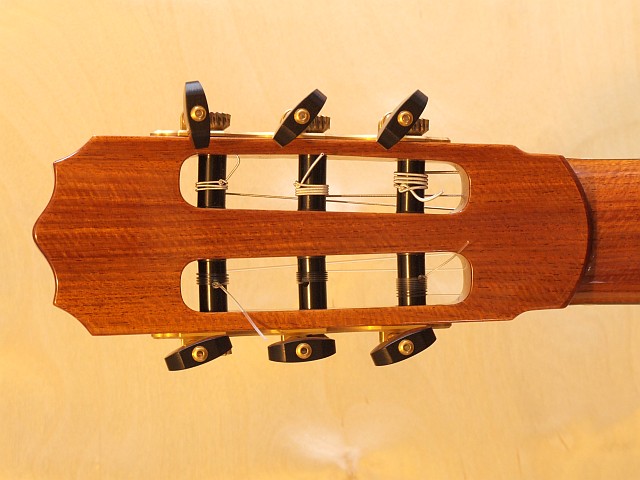
- Headstock back.jpg (72.93 KiB) Viewed 22267 times
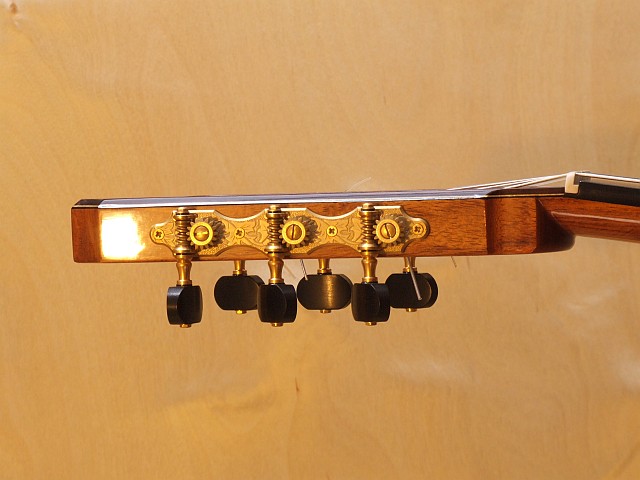
- Headstock side.jpg (64.67 KiB) Viewed 22267 times
The tuners are the Gotohs with the bearing on the end of the barrel. Really nice. Probably the best I've used.
Re: A couple of classicals
Posted: Sun Oct 21, 2012 12:04 pm
by charangohabsburg
Hi Trevor, thank you very much for the additional pictures. I can see now that you simply "moved the machines out of the way". A very neat solution, indeed. BTW, this is the first time I consciously see a classical headstock with a total thickness apparently greater than 20mm (just like on my first charango).
I was not aware of the existence of the premium Gotohs with this plate shape! How do these (slightly thicker) end-brearings of the rollers go into the holes? Did you have to get a 10.2mm drill bit to make or enlarge the holes?
Re: A couple of classicals
Posted: Sun Oct 21, 2012 2:17 pm
by Trevor Gore
The end bearings of the Gotohs have what looks like an 'O' ring on them, presumably to ensure a tight fit. I just used a 13/32" drill (pretty much standard practice) which converts to 10.3mm and that is pretty much exactly what you need (and what fits my shop-made drilling jig). No need for stepped holes or anything.
Re: A couple of classicals
Posted: Sun Oct 21, 2012 10:14 pm
by charangohabsburg
Thanks again Trevor, that sounds good.
Re: A couple of classicals
Posted: Tue Oct 23, 2012 11:03 am
by Steve_E
Trevor, love the Rosette.
I've always loved that style of tile, but can't quite visualize how to replicate (not that I want to copy you

). Do you have a quick description of your process?
Thanks,
Steve
Re: A couple of classicals
Posted: Tue Oct 23, 2012 1:20 pm
by Trevor Gore
It's just planks and logs like traditional mosaic rosettes, but you don't need to reduce it all to the minimal square section of the smallest thickness. As ever, it's keeping everything in register whilst gluing that's the hard bit, but you can use perspex "moulds" to help you there.
I've seen some pictures of similar rosettes where the zig-zag shows a slight skew, which indicates to me that the pieces were glued up as a sort of spiral which wasn't quite under control. I would imagine it's pretty hard to do it that way, hence the planks and logs approach.